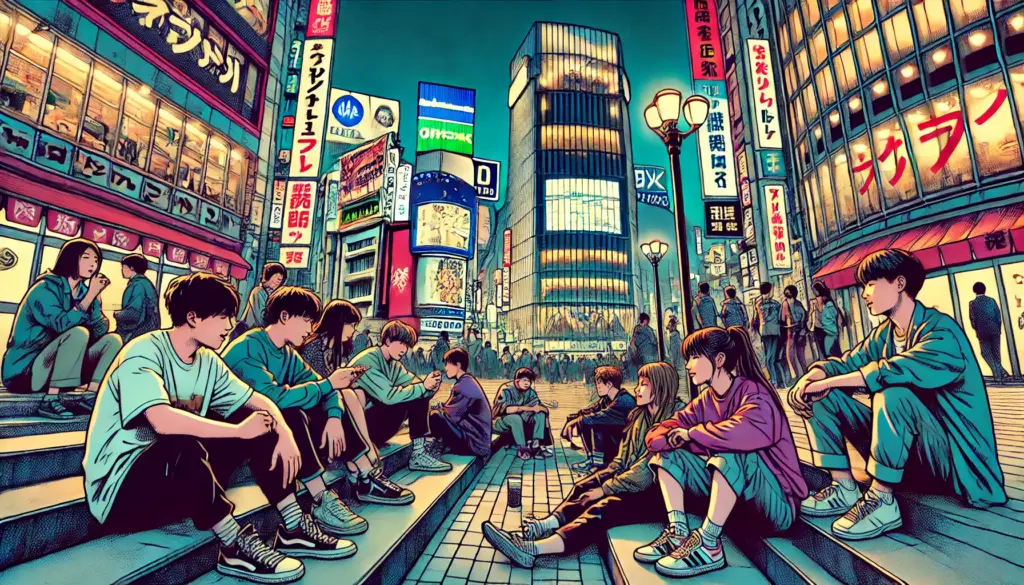
Japanese youth today face a striking challenge: a lack of places to release their emotions, energy, and frustrations. This tension has given rise to a visible phenomenon—the so-called “Tō-Yoko Kids” in Shinjuku’s Kabukichō district. Their presence has sparked nationwide debate about youth isolation and urban society.
Who Are the “Tō-Yoko Kids”?
The nickname comes from the area beside the TOHO Building in Shinjuku, shortened to “Tō-Yoko.” Teenagers and young adults, some still in junior high or high school, began gathering there several years ago. While the name was originally coined by nightlife workers, the youth themselves eventually embraced it as an identity and community label.
They are not an organized group with leaders or rules. Instead, they represent a spontaneous congregation of young people searching for connection in the bustling, chaotic energy of Tokyo’s neon streets.
Why Do They Gather There?
1. Escape From Loneliness
Many of these young people lack safe spaces at home or school. Some come from troubled households, others face bullying, and many simply feel invisible in everyday society. The bright chaos of Shinjuku becomes a temporary escape from reality.
2. A Sense of Belonging
Through social media, word spread that Tō-Yoko was a meeting point. Teens who felt out of place elsewhere could come and instantly find peers who shared similar struggles. For many, this was their first taste of genuine community.
3. Recognition and Validation
In a society where conformity is prized, these gatherings serve as a way for youth to say, “I exist.” Posting photos or updates from Tō-Yoko on social platforms gives them a sense of visibility, even if fleeting.
The Deeper Social Problems
The rise of Tō-Yoko Kids highlights broader issues in Japan. Unlike past generations that had community centers, after-school clubs, or strong neighborhood ties, today’s youth often navigate life without adults they can trust. This leaves them seeking alternative “third places” where they can feel noticed.
The neon glow and constant noise of Kabukichō create an environment that feels alive and accepting, even if it comes with risks. In many ways, Tō-Yoko is not the problem itself but a symptom of the absence of supportive environments for young people.
Risks They Face
These gatherings are not without danger. Reports of underage drinking, substance abuse, exploitation, and self-harm are common. Some youths end up hospitalized due to overdoses or injuries. Others fall into the hands of predatory adults who take advantage of their vulnerability.
The very space that provides freedom and belonging can also expose them to serious harm.
How Society Responds
Authorities and local organizations have attempted interventions. Police patrols are more frequent, and outreach groups try to offer counseling or alternative meeting spots. Yet many youths return to Tō-Yoko after being moved along, showing that enforcement alone cannot address the underlying problem.
What they need is not punishment, but safe, welcoming environments that meet the same needs: recognition, freedom, and connection.
A Path Forward
Imagine urban spaces designed with youth in mind—late-night community rooms, art and music hubs, or casual drop-in centers where they can meet friends, talk freely, and feel seen. Instead of neon backstreets, they would have safe oases for self-expression.
Addressing the issue means acknowledging that these young people are not simply “delinquent.” They are searching for belonging in a society that often leaves them isolated. Providing genuine alternatives is the only way to guide them toward healthier futures.
Final Thoughts
The story of Tō-Yoko Kids is not just about Shinjuku. It is a mirror held up to Japanese society, revealing how many young people feel unseen, unheard, and disconnected. While the risks are real, their gatherings are a form of survival—a way of carving out identity in a world that gives them little space.
By shifting the narrative from control to care, Japan has the chance to transform this issue into an opportunity: to reimagine how a modern city supports its youth, and how society ensures no one grows up believing their only refuge is on the edge of neon-lit streets.



















































